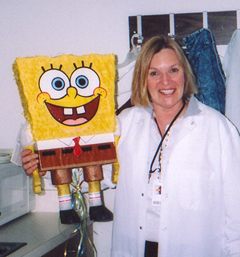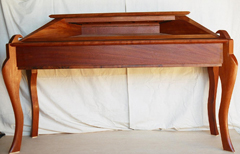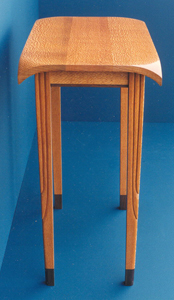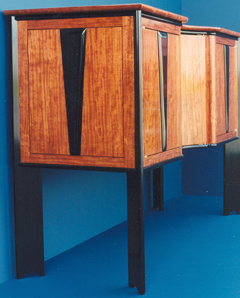
Single, twice divorced, and fifty-six, Alice Porembski is about the happiest and most contented furniture maker/designer I’ve interviewed, and also one of the best. A member of The Furniture Society, the Siskyou Woodcraft Guild, and a ‘Master’ member of the Baulines Craft Guild, she does not even bother with a web site. For her, selling and expanding is not what it’s about.
“I have always built furniture, and I will always build furniture,” she told me. “Fame is not what I am after. I like recognition, and I enjoy hearing from people who like my work, but I don’t do this to get bigger. I am happy where I am. I do it because it is more of a passion than a compulsion. I have an aversion to mass production. I tried that, tried having employees, and I didn’t like it.”
Most of her pieces are sold by word of mouth, or by recommendation, or from those who have seen her work in galleries. She describes her work as eclectic and ephemeral, with clean, spare lines; fairly traditional, nothing wild and crazy.
“I feel that the challenge of modern fine woodworking is to bring ordinary methods and familiar forms into new light, whether they are introducing whimsy, drama, fantasy or exploring beauty and simplicity. All of my designs offer an alternative to conventional furniture. I like to think they will still be around and appreciated long after I am gone.”

Porembski was born in Chicago of Polish parents. Her maternal grandfather was a furniture designer and maker who was brought to this country by the Lemoine Parlor Furniture Company around 1910. As a result, she grew up making things, often with her mother. “We’d make a doll house, doll furniture, whatever. I would make things to entertain myself. It was a very craft-oriented household.” She studied anthropology at the University of Illinois, but often went to the Lane Technical Evening School, primarily in order to have access to their equipment.
“After I finished school, I moved to Vermont in 1972, and from then on, worked as a woodworker. I built houses and cabinets in the collective shop of a commune called ‘New Hamburger,’ and showed some pieces in a local gallery called ‘Artisan’s Hand.’ I got sick of the cold weather, and moved to Portland, Oregon in 1981. I worked with the Oregon School of Arts and Crafts, and got to use their shop. My day job, at the time, was as a remodeling contractor. In 1984, I moved to Oakland, California, and did cabinet work and carpentry for a company called ‘Creative Spaces.’ Throughout, I always made some furniture of my own designs either on commission or on spec.”

She moved north to Redding, California, while married. She and her then-husband worked together as remodeling contractors, and built custom cabinets and furniture. That, she says, may have been the first step toward her divorce.
Porembski’s design process involves much more than just drawing. “What I do is also building relationships. I am good friends with all my clients. You get to know someone very well, and they get a piece of you, also. For example, I’m working on a design now. I went to the house, saw the room the piece would be in, and asked what of their furniture they really like. From that, I got the ideas of where to proceed. In a month, I came back with some thumbnail sketches and a model of some ideas that I had. I usually try to build in something that I have never done before, just to make it interesting.”

“Certainly, in the creative world, you must reach beyond what has been done, and have the vision for reinventing. Then there is luck. Sometimes, you wake up in the morning and have a picture in your head of something you have to build. Of course, anything I really did not like became firewood. I make legs all the time. I have a bucket full of experimental legs.”
She also works part-time in a pharmacy to make sure the vagaries of custom woodworking budgets don’t unseat her grasp on day-to-day expenses. “I think people do woodworking to do something that matters, that is a challenge, that is mapping your imagination, rather than simply making money. People should do what they are good at, use their talent, challenge definitions, and make things that matter.”
Wise words from a wise, and very talented, woman.





